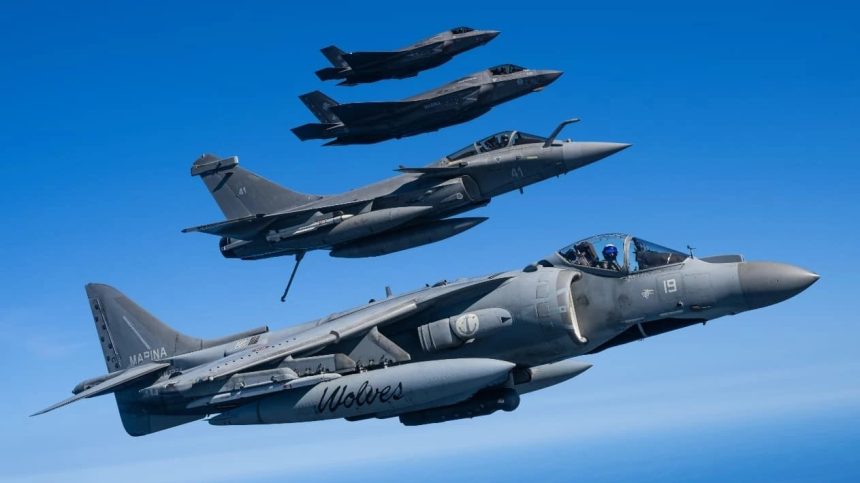The Italian F-35s deployed for the first time to Landivisiau Naval Air Base, integrating 5th gen aircraft in the training of the French Navy’s Rafales.
The French Navy’s (Marine Nationale) Landivisiau Naval Air Base hosted for the first time the Italian F-35Bs, as well as AV-8B+ Harrier IIs, from Jul. 3 to 11, 2025. The deployment saw the Italian 5th gen aircraft training with the French Rafale Ms.
A total of six F-35Bs and four AV-8B+ Harrier IIs visited France. Two F-35Bs were from the Italian Air Force’s (Aeronautica Militare) 101° Gruppo (101st Squadron), which the service recently reactivated on Jul. 1, 2025.
The remaining aircraft were from the Italian Navy’s (Marina Militare) Gruppo Aerei Imbarcati (Embarked Aircraft Squadron) “Wolves.” The unit currently operates both the Harrier and the F-35B Lightning II, and in future it will fully transition to the F-35B.
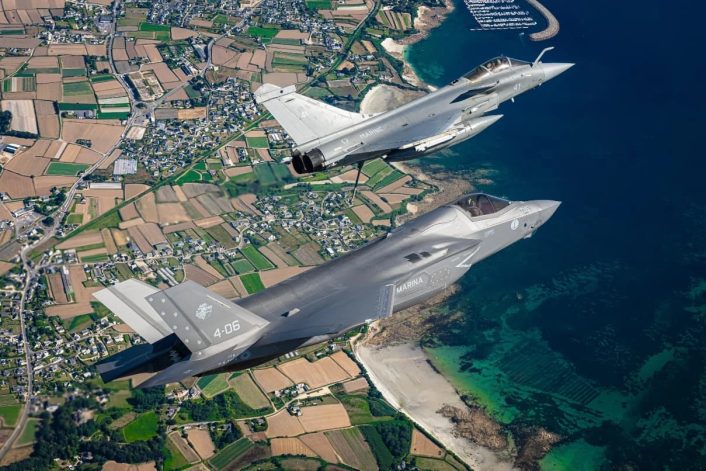
It is important to note that the French Rafale Ms already trained with the Italian F-35Bs and AV-8Bs before. In fact, in May 2024, four Rafales visited Grottaglie Naval Air Station in southern Italy, the home of the “Wolves,” during the final phase of the Mare Aperto 24-1/Polaris 24 exercise, part of the larger Neptune Strike.
Durante la Neptune Strike, 4 velivoli Dassault Rafale della @MarineNationale si sono rischierati presso la Stazione Aeromobili di Grottaglie, per addestrarsi insieme ai Lupi del Gruppo Aerei Imbarcati per prepararsi alla fase finale della #MareAperto 24-1/Polaris 24. pic.twitter.com/15JmWimPeG
— Marina Militare (@ItalianNavy) May 8, 2024
Landivisiau Naval Air Base (or BAN Landivisiau), in northwestern France, hosts the Marine Nationale’s Flotilla 12F, which is assigned the Rafale Ms operating from the FNS Charles De Gaulle aircraft carrier. The deployment of the Italian F-35s there is part of a long-running French effort to better prepare to operate together with 5th generation fighters flown by allied and NATO nations.
It is also worth noting that the French Navy’s Rafale Ms have already flown with F-35s in the past, the most recent instance being during Exercise Pacific Steller in February 2025. On that occasion, F/A-18E/F Super Hornets and Rafale Ms conducted cross-deck operations on the FNS Charles De Gaulle and the USS Carl C. Vinson, as well as joint operations with E/A-18G Growlers and F-35C Lightning IIs.
The exercise
A video released by the Marine Nationale offered a glimpse into the activities, with the Italian and French crews planning and then flying together. Neither of the services have specified the nature of the training missions included in the exercise.
#CoopérationMilitaire | Unis dans les cieux : « Landivisiau fa la storia! » 🛩️🇫🇷🇮🇹
La base d’aéronautique navale accueille pour la première fois les chasseurs F35 B italiens. pic.twitter.com/tMW7n48Px9
— Marine nationale (@MarineNationale) July 11, 2025
The drills may have involved relatively simple maneuvers like Basic Fighter Maneuvers (BFM) and practicing established communication protocols to support interoperability. The posts by both services also hint at more complex scenarios based on 4th and 5th gen aircraft cooperation.
The specific nature of the latest drills suggest a targeted effort to develop operational tactics in the event France has to conduct operations with allies. This could be either in the European or the Pacific theater, where both Rome and Paris have deployed their forces in the recent past.
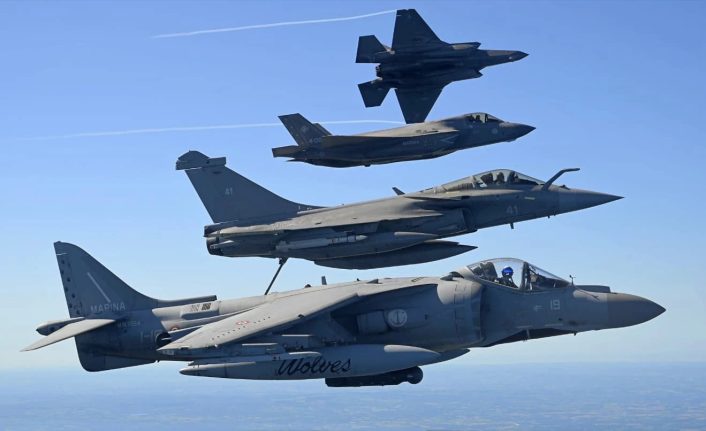
In fact, the French Naval Aviation (Aeronautique Navale) listed three objectives of the Franco-Italian exercise in its Instagram post: “Strengthen the interoperability between allied forces; Prepare tomorrow’s aircraft operations; Train to modern high intensity scenarios.”
The service then added that the key goal of the exercise was to enable the French Embarqué Air Group “to prepare to operate with 5th generation aircraft used by Italy and other NATO nations.” Further confirming this, the post added that “Cooperation, sharing experience and operational efficiency [are] at the heart of this Franco-Italian initiative.”
View this post on Instagram
‘Interoperability, integration and preparing for future conflicts’
In a Facebook post, the Marine Nationale said that “this event marks a turning point in our cooperation with NATO Allied Forces, integrating 5th Generation aircraft into our training.”
Similarly, the Italian Navy’s Instagram post described the exercise as an intense week after which the cooperation and integration of the three services involved is stronger. “Together we are stronger. Ready and trained for future scenarios,” said the service.
View this post on Instagram
Further demonstrating the expanded defense and strategic cooperation between Italy and France, the Marine Nationale also announced that an Italian Navy SH-90 helicopter (Italian designation for the naval variant of the NH-90 helicopter, which France calls the NH90 Caïman) took part in the flypast during the Bastille Day Parade in Paris, accompanying French helicopters.
The image released by the service showed an Italian SH-90 flying close to the FNS Charles De Gaulle aircraft carrier during a previous deployment. The Marine Nationale said “Italy and France are partners in maritime approach surveillance missions, rescue operations, or interceptions at sea as well as in the air,” describing the foundation for the rotary wing platforms’ participation.
🇮🇹 | ITALIE
Un Caïman 🇮🇹 accompagnera nos hélicoptères de la Marine nationale.
➡️ L’Italie et la France sont partenaires dans les missions de surveillance des approches maritimes, le sauvetage ou l’interception en mer comme dans les airs. pic.twitter.com/7ntgPLSlfN
— Armée française – Opérations militaires (@EtatMajorFR) July 13, 2025
The SH-90 wasn’t the only Italian asset in the parade, as an Italian Air Force F-2000A Typhoon of the 51st Wing was also present, flying in a formation together with French, British, German, Spanish and Swiss fighters.
Italian Navy F-35Bs and AV-8B+ Harriers
Grottaglie Naval Air Station, in southern Italy, hosts the Italian Navy’s Gruppo Aerei Imbarcati (Embarked Aircraft Squadron) “Wolves,” which is assigned the fighter jets operated on the ITS Cavour aircraft carrier. The squadron operates both the Harrier and the F-35B Lightning II, with the plan of fully transitioning to the latter in future.
The ItAF operates both the CTOL (Conventional Take-Off and Landing) F-35As and the STOVL (Short Take-Off Vertical Landing) F-35Bs. The latter also operate off the ITS Cavour aircraft carrier together with the Navy.
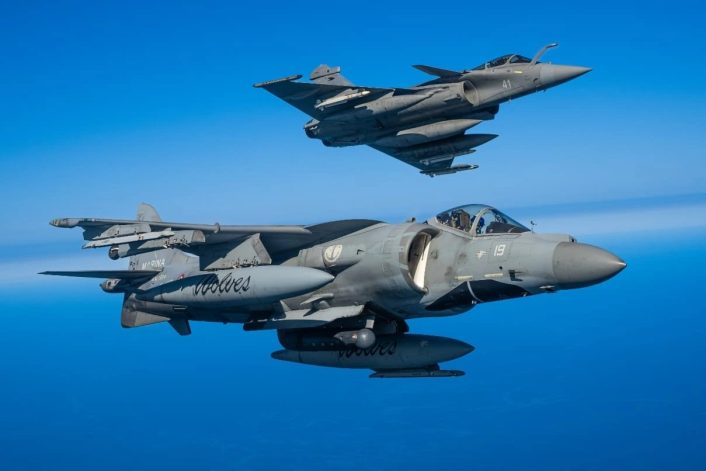
As touched upon in previous reports by The Aviationist, similarly to the Royal Air Force (RAF) and Royal Navy (RN), the two Italian services jointly train, operate and maintain their F-35B fleets. The Navy’s F-35Bs have also been based with the Air Force’s F-35s at Amendola Air Base, home of the ItAF’s 32° Stormo (Wing), and the CSAS (Centro Supporto Addestramento e Standardizzazione).
This allows for more efficient logistics and maintenance until the Navy has enough aircraft to move back to Grottaglie. At the same time, this allows to synergize TTPs (Tactics, Techniques and Procedures) as both services often train together, operate their F-35Bs from austere locations and embark on the ITS Cavour.
Furthermore, all Italian F-35B pilots are being trained at Amendola, after attending the ground school at Marine Corps Air Station Beaufort, South Carolina. After acquiring the Limited Combat Ready qualification, pilots then continue to train for the full combat readiness with their assigned squadrons.
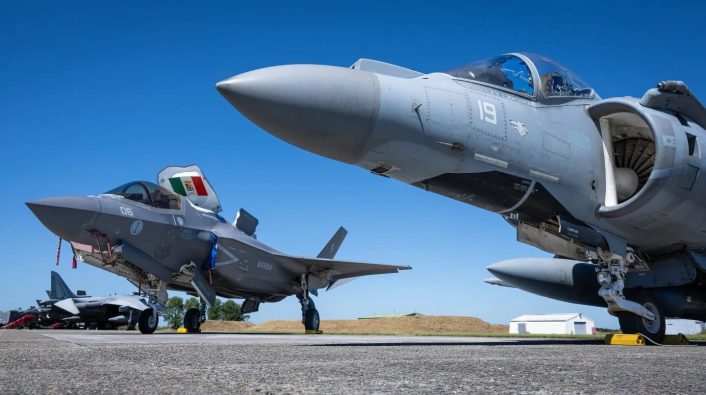
In the past, there have been disagreements whether the Italian F-35B should all go to the Navy or be shared with the Air Force, and also if they should all be based at the same airfield. However, the Italians now aim at a “joint capability” with the Italian Air Force and Navy operating their own aircraft in their own units. Still, when needed, the F-35Bs of both services will integrate and operate under a single chain of command from land-bases or from an aircraft carrier or landing helicopter dock.
The Navy currently operates six F-35Bs while the Air Force currently operates two, with each service planned to receive 15 airframes. In 2024, as part of the new multi-year defense planning, Italy announced an increase of the F-35 order, with 15 new F-35As for the Air Force and 5 F-35Bs for the Navy.

